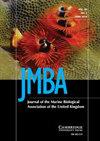历史沉积物特征对多毛类分布预测的影响——以所谓的泥泞生境铲头蠕虫为例(链接动物:麦哲伦科)
IF 0.9
4区 生物学
Q3 MARINE & FRESHWATER BIOLOGY
Journal of the Marine Biological Association of the United Kingdom
Pub Date : 2023-11-24
DOI:10.1017/s0025315423000826
引用次数: 0
摘要
铲头虫是不列颠群岛上常见的多毛纲动物,在许多生态调查中都有记录。然而,对它们栖息地条件的了解很差,主要基于历史记录中对沉积物的视觉观察。本研究通过重新分析博物馆海洋监测调查的沉积物特征和深度,研究了两种形态和行为多样的Magelona alleni和Magelona minuta物种丰富度和地理分布的驱动因素。虽然这两个物种在历史上都与泥质沉积物有关,但这里的记录表明,M. alleni出现在广泛的沉积物中,但在砂含量超过25%的地方更为丰富。相比之下,M. minuta在颗粒直径与丰度之间表现出负线性关系,证实了先前的研究结果,即该物种在细粒泥浆中丰富。深度记录显示,在60 m以下以alleni为主,minuta是一个独特的近海物种。这些差异可能归因于种间形态和活动的差异:M. alleni是矮胖的,住在管状,而M. minuta是脆弱的,小,和相当的活动。为了证实这些发现,使用Udden-Wentworth粒度尺度对M. alleni管状沉积物颗粒进行了分类,并表明沙子是管状结构的关键成分。总的来说,本研究强调了M. alleni的沉积物参数在历史记录中被误解和概括,强调了定量沉积物分析在确定Magelona栖息地中的重要性。本文章由计算机程序翻译,如有差异,请以英文原文为准。
Impact of historic sediment characterisation on predicting polychaete distributions: a case study of so-called muddy habitat shovelhead worms (Annelida: Magelonidae)
Shovelhead worms are common polychaetes around the British Isles and have been recorded in numerous ecological surveys. Yet, understanding of their habitat conditions is poor, based heavily on visual observations of sediments from historical records. In this study, the drivers of abundance and geographical distribution of two morphologically and behaviourally diverse species Magelona alleni and Magelona minuta are investigated by reanalysing sediment characteristics and depths from museum marine monitoring surveys. Although both species are historically associated with muddy sediments, the records herein suggest that M. alleni occurs in an extensive range of sediments, but is more abundant at localities with more than 25% sand. In comparison, M. minuta shows a negative linear relationship between grain diameter and abundance, corroborating previous work that the species is abundant in fine-grained mud. The depth records show that while M. alleni predominates below 60 m, M. minuta is a distinct offshore species. These differences may be attributed to the interspecific variation in morphology and motility between the species: M. alleni is stout and tube-dwelling, while M. minuta is fragile, small, and fairly motile. To corroborate these findings, sediment grains from tubes of M. alleni were classified using the Udden–Wentworth grain size scale and suggest sand is the key component for tube construction. Overall, this study highlights that sediment parameters for M. alleni have been misinterpreted and generalised in historical records, emphasising the importance of quantitative sediment analysis in defining the habitat of Magelona .
求助全文
通过发布文献求助,成功后即可免费获取论文全文。
去求助
来源期刊
CiteScore
2.30
自引率
8.30%
发文量
68
审稿时长
3-8 weeks
期刊介绍:
JMBA is an international journal, publishing original research on all aspects of marine biology. It includes pioneering work taking place today on major issues concerning marine organisms and their environment. Subjects covered include: ecological surveys and population studies of marine communities; physiology and experimental biology; taxonomy, morphology and life history of marine animals and plants; and chemical and physical oceanographic work. Included with 2010 online subscriptions: Marine Biodiversity Records.

 求助内容:
求助内容: 应助结果提醒方式:
应助结果提醒方式:


